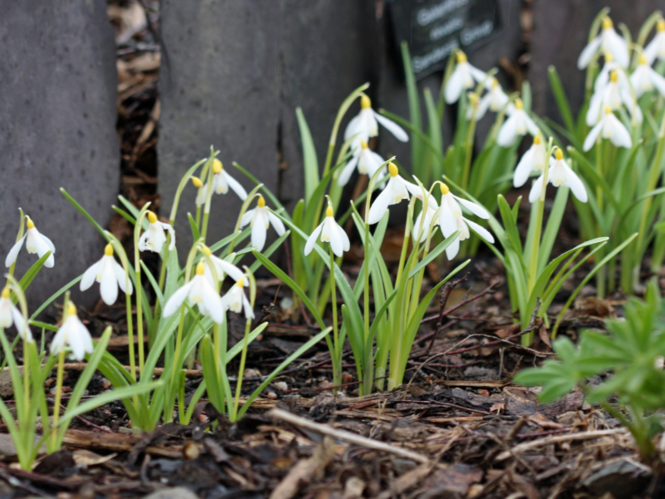Snowdrop Hints and Tips
by Helen Rushton, Bruckhills Croft Garden Owner
In their natural habitat, snowdrops generally grow on the edges of woodland or scrub where there is good light for most of the day, with periods of dappled shade. The soil in these areas is usually free draining from the leaf mould from the nearby tree canopy, but never dries out completely. It is also never wet and boggy. If you can bear this in mind when planting snowdrops, you should have success.
○ If you don’t have a woodland in your garden, deciduous shrubs such as Lilac, Buddleia, or Witch Hazel, and shrubs with an open canopy of leaves such as Japanese Maples, can be used as your woodland edge plants. Even evergreens can be good planting companions if the canopy is raised to let the light in at soil level.

○ Herbaceous plants such as hardy Geraniums and Astrantia are also good companions. They disappear in the winter allowing the snowdrops to perform, while in summer provide a shady canopy over the dormant snowdrop bulbs stopping them from drying out.
○ Snowdrops do well on pots, if they are large enough that they don’t freeze solid in winter or dry out completely in summer. Pair the snowdrops with other winter performers like scented Winter Box and put near a door to appreciate as you walk past – then in summer stand in a shady out-of-the-way corner.
○ If you have really free draining/sandy soil, and you struggle to grow common snowdrops, try instead one of the varieties of Galanthus gracilis species of snowdrop. They naturally come from drier areas so will tolerate a drier sunnier aspect.
○ Are you bothered by moles and voles, who tunnel through your borders scattering bulbs on the surface? Try planting your snowdrops in aquatic pond baskets and plunging them into the border. The bulbs benefit from being at the same temperature and moisture as the surrounding soil, but any tunnelling rodents bypass them. They are also useful if you are renting or intending to move… the whole basket can be lifted and planted in the new garden.
○ Don’t overfeed your snowdrops, they don’t need it and too much nitrogen will encourage lush foliage at the expense of flowers which will also attract pests. If you really think your soil is poor, add a mulch of leaf mould and a light dressing of a slow-release fertiliser such as bonemeal just as the bulbs appear which will breakdown in the soil and become available to the snowdrop as the foliage dies down and the bulbs are bulking up for next year.
○ Snowdrops don’t like to be overcrowded and benefit from being lifted and split every 3-4 years. If you can remember where they are, do it in mid-summer when they are dormant and naturally no pests flying, or you can do it when they are ‘in the green’. Interestingly in the wild you will often see bulbs pushed to the surface of congested clumps where animals and birds can distribute them…remember those pesky moles and voles?
○ To fully appreciate the flowers when you visit one of our snowdrop gardens, take along your favourite knee pads or garden kneeler – it will save you from getting muddy knees!
Thank you so much Helen, you have certainly inspired us to get out in our gardens to tend to our snowdrops this season!
Bruckhills Croft is open for snowdrops by arrangement 3 February - 17 March. Awarded National Collection status for Galanthus (snowdrops) in 2021.
You can also hear Helen on this fascinating podcast about her snowdrops, with the Scotland Grows Show.
Listen to the podcast here
View all of our 2024 snowdrop openings here


